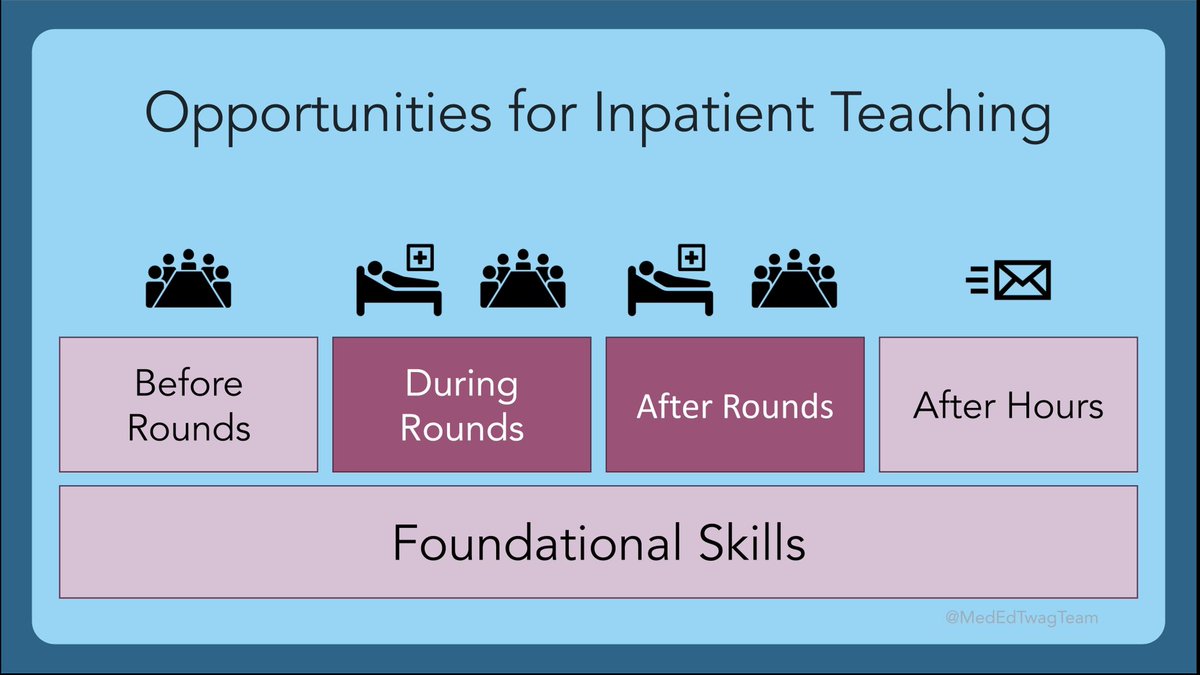1/ After reading #MedEdTwagTeam @JenniferSpicer4's #TweetorialTuesday last week, you’ve decided to teach exam skills at the bedside.
Awesome! Now how do you structure your exam skills teaching? We will review some strategies this week!
#MedTwitter #MedEd
Awesome! Now how do you structure your exam skills teaching? We will review some strategies this week!
#MedTwitter #MedEd

2/ As a reminder, we are continuing our discussion about opportunities for inpatient teaching during rounds.
Today is week 2 of 3 in our physical exam series.
Today is week 2 of 3 in our physical exam series.

3/ These are the 4 ways I incorporate physical exam teaching on rounds.
💎Skill of the Day
💎Diagnostically Relevant
💎Clinical Trend
💎Imaging Correlation
Depending on how much time you have, you can choose just 1 method, or incorporate all 4 on a given day!
💎Skill of the Day
💎Diagnostically Relevant
💎Clinical Trend
💎Imaging Correlation
Depending on how much time you have, you can choose just 1 method, or incorporate all 4 on a given day!

4/ Skill of The Day - Pick 1 skill & practice it on every pt on rounds, even if unrelated to the pts presentation.
Frequent repetition on rounds allows learners to:
- receive coaching and immediately implement change
- consolidate the skill quickly
- compare normal vs abnormal
Frequent repetition on rounds allows learners to:
- receive coaching and immediately implement change
- consolidate the skill quickly
- compare normal vs abnormal
5/ Diagnostically Relevant - Pick one skill/finding per pt that's relevant to the chief concern or medical history.
This allows learners to:
- Hone reasoning skills
- Understand the hypothesis-driven physical exam, including LR of exam findings
- Develop PE illness scripts
This allows learners to:
- Hone reasoning skills
- Understand the hypothesis-driven physical exam, including LR of exam findings
- Develop PE illness scripts
6/ @ChrisDJacksonMD talked about the hypothesis-driven history a few weeks ago here:
For more on the hypothesis-driven physical exam, see👇 sciencedirect.com/science/articl…
https://twitter.com/ChrisDJacksonMD/status/1496179697511768065?s=20&t=GW-mJxuT_xfdoK7QI7zCJA
For more on the hypothesis-driven physical exam, see👇 sciencedirect.com/science/articl…
7/ Clinical Trend - Pick a finding that will change over the course of the pt's hospitalization & repeat it daily on the same pt.
This allows learners to:
- Correlate severity of disease with the PE
- Get in their skills reps
This allows learners to:
- Correlate severity of disease with the PE
- Get in their skills reps
8/ Imaging Correlation - Pick an exam that has a correlate finding on imaging.
This allows learners to:
- Compare dx utility of exam vs imaging
- Associate physiology w/ exam w/ imaging finding
Some pts also enjoy looking at & learning about their imaging results!
This allows learners to:
- Compare dx utility of exam vs imaging
- Associate physiology w/ exam w/ imaging finding
Some pts also enjoy looking at & learning about their imaging results!

9/ Let’s put this into practice.
Say this is your pt list & you are preparing in the morning like @JenniferSpicer4 recommended (
Take a pause.
What exam skills teaching options are there for each of these pts and exam approach categories?
Say this is your pt list & you are preparing in the morning like @JenniferSpicer4 recommended (
https://twitter.com/JenniferSpicer4/status/1440369345142525960).
Take a pause.
What exam skills teaching options are there for each of these pts and exam approach categories?

10/ Here’s an example of exam skills you could observe and/or teach for each pt & exam indication.
Again, you won’t have time to do all this @ once. But as you can see, there are so many opportunities & potentially overlapping skills in between patients!
Again, you won’t have time to do all this @ once. But as you can see, there are so many opportunities & potentially overlapping skills in between patients!

11/ If you don’t have time on rounds, you can use these same 4 methods for teaching the exam during bedside attending rounds later in the day.
#MedTwitter, do you have other ways that you incorporate physical exam teaching on rounds?? We’d love to hear from you!
#MedTwitter, do you have other ways that you incorporate physical exam teaching on rounds?? We’d love to hear from you!

12/ Stay tuned for my thread next week on strategies to ENGAGE EVERYONE while teaching physical exam at the bedside!
Make sure to follow @MedEdTwagTeam members @GStetsonMD @JenniferSpicer4 @ChrisDJacksonMD & @YihanYangMD so you don’t miss anything!
Make sure to follow @MedEdTwagTeam members @GStetsonMD @JenniferSpicer4 @ChrisDJacksonMD & @YihanYangMD so you don’t miss anything!

• • •
Missing some Tweet in this thread? You can try to
force a refresh






















